Journey to the Singularity || The Black Hole
looking for the stars
finding the constellation
through the map of our scars.
Like the universe,
our wounds are deep,
the pain that we feel,
It's infinite”
...
Bleeding rhymes

Author; Edited; Licence : CC BY 2.0
Below are the points that we will discuss in this article:
- A short recap
- Way to the ultimate goal
- Singularity
- Say goodbye to our Physics
- Event horizon
- Types of Black Hole
- No-hair theorem
- Hawking Radiation
- Hunt for Black Hole
A short recap
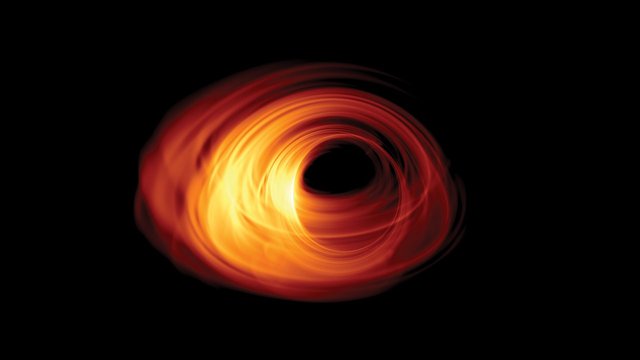
[image credits: ESO/ Bronzwaer Licence: CC BY 4.0]
The first idea of something like black hole came on 18th century. On 1783 scientist named John Michel proposed a phase of large massive body on his paper “Dark Star”. Where he mentioned it as- if an object has a huge mass with a small size there might be a massive pull of gravity by that object that the escape velocity from it exceeds the velocity of light. Renowned scientist Pierre-Simon Laplace pushed it further on his book “The System of the World” by using it alongside Newtonian gravity.

Image credits: Homemade
Those are the people whose work boosted black hole astronomy.
On 1915 using Albert Einstein's theory of general relativity physicist Karl Schwarzschild gave a mathematical solution for that type of heavy objects by introducing Schwarzschild radius. After that it grew a massive hit on scientific community. Physicists like J. Robert Oppenheimer and Subrahmanyan Chandrasekhar developed a stable model of neutron star collapsing into singularity. Although we credit John Wheeler for coining the name “black hole” in 1967 for the first time, that's not entirely true. It is science writer Ann Ewing who phrased it first on 1964 in her article "'Black Holes' in Space".
Way to the ultimate goal
We can think of our universe as an infinite playground. Where we have some finite common building blocks for every massive objects that exists. Approximately 13.8 billion years ago an event called Big-bang set the space-time free and filled the universe with matter and energy. Between 10 to 1200 seconds after Big bang, primordial nucleosynthesis happened. Through this universe had mass abundance of following.
Hydrogen--75%
Helium--25%(Approx)
Almost zero amount of other heavier elements.
But that is not the universe that we are observing today, after approximately 13.8 billion years after the big bang. Current abundance of some basic elements are following.
| Atomic number | Chemical element | Current abundance |
|---|---|---|
| 1 | Hydrogen | 73.9% |
| 2 | Helium | 24% |
| 8 | Oxygen | 1% |
| 6 | Carbon | 0.5% |
| 26 | Iron | 0.11% |
| 7 | Nitrogen | 0.1% |
| 92 | Uranium | 2×10^-8% |
| 79 | Gold | 6×10^-8% |
For more about Element Abundance in the Universe- Here.
Continuous stellar nucleosynthesis and some biggest explosion on space made this change. Nuclear fusion inside any star creates Helium from Hydrogen. When a star ran out of their primary fuel Hydrogen, because of the pressure instability, the Helium core inside that star tries to collapse. In the meantime, this shrinking process creates enough energy to fuse two Helium nuclei into Carbon. For a star like our sun this is the last stage of her lifecycle. Because carbon is too strong to be further compressed by the amount of mass of the surrounding material. After which the process will continues to red giant then a white dwarf and finally to a black dwarf . If the mass of white dwarf, at any chance ( By sucking mass from a binary companion star), exceeds Chandrasekhar Limit of about 1.4 Solar Masses or 2.765×10^30 kg, there would be a type-Ia supernovae explosion. This type-Ia explosion is very important for their even and uniform process of explosion. Scientists use them as a constant candle to determine the distances in space.
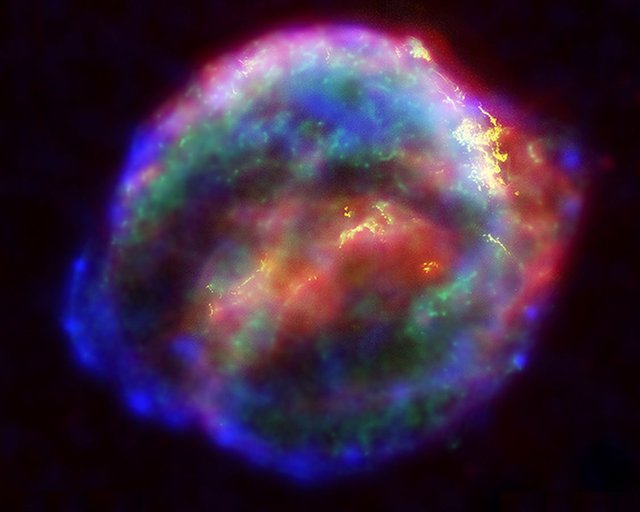
Author: NASA ; Licence: Public Domain
Composite image of Kepler's supernova
But for a star approximately 8 times bigger than our sun, fate has something very dramatic in store. After being a red giant the star again starts to collapse on its own gravity (Game of gravity). As it shrinks, the heavier core of the star grows hotter and denser which kickstarts a new set of nucleosynthesis. This collapsing and fusion process goes on perfectly till it creates Iron of periodic table. As the Iron nuclei is the most stable one because of its high binding energy per nucleon, the star is no longer able to produce energy in the core via further nuclear burning stages (Fusion or Fission) and thus fusion ceases.
Now the star is facing its final gravitational collapse. There is nothing at its center to re-establish the stability against the attraction force of gravity. Temperature is rising exponentially on its core. It could reach over 100 billion degrees. After passing an appropriate maximum threshold (Exceeding the Chandrasekhar limit, electron capture, pair-instability or photodisintegration ) the core of the star collapse within less than a second (Only the core, without the outer sphere). The heavier core recoils out from the star with a massive energy surge of Neutrino. As the radiation shock and high energy Neutrino encounters matters on star’s outer shell, due to intense energy, production of more heavier element than Iron starts through nucleosynthesis of Iron. This radiation is more massive and brilliant compared to any other explosions on space. Any heavier element than Iron that we see in periodic table came out of existence from this process. Prove to the fact that we all are stardust.
For instance consider supernova ASASSN-15lh. Discovered back in 2015. Since then it is the most powerful supernova that we have ever seen. It exploded by emitting 570 billion times more radiation compared to our sun. in other words, 20 times brighter than all the stars combined in our Milky Way Galaxy.
For more about this, visit- Here
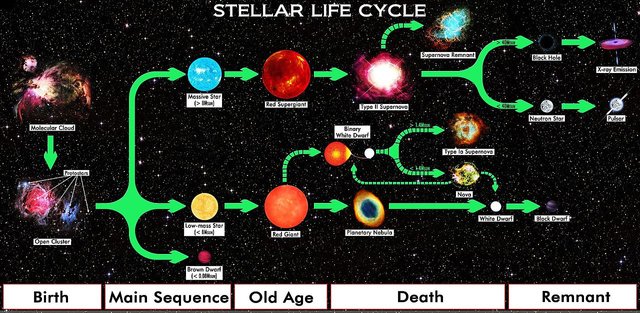
Author: R.N. Bailey; Licence: CC BY 4.0
Star Life Cycle Chart
In a relatively smaller star where the core became all carbon and remain stable and die cold becoming black dwarf or explodes in type-Ia supernova. But if the origin star is more massive that 10 times of our sun than the core collapses while exploding. Producing a central core of Neutronium. The future of the core is now depending both on the nature of the collapse and the initial mass of progenitor star.
Neutron star
As you can see at this stage of a star, the remnant core could be either a Neutron star or a Black Hole. The process may vary for the starting mass of origin star. A star weighted between 10 to 29 of solar mass can result a stable Neutron star. This is the last stage of a star where it is still a thing in this universe. There is a limit of how massive a neutron star can be before converting into a Black hole. Recently astrophysicists at Goethe University Frankfurt published a research paper where they showed that the highest mass of a stable Neutron star can be 2.16 solar mass. As the density of these stars is enormous, a neutron star having twice the mass of the sun can be only 12 kilometres in radius.
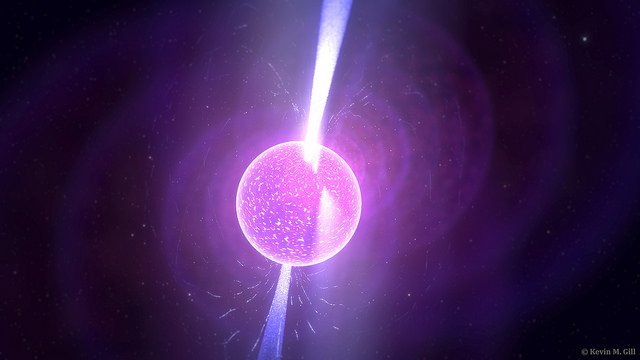
Author: Kevin Gill; Licence; CC BY 2.0
Simulation of a neutron star.
Most of the neutron star that we have observed had mass around 1.4 solar mass. Because it’s the sweet spot for stability in Neutron star. Biggest neutron star ever detected is PSR J1614-223, weighted 2.01 solar masses and located about 3,000 light-years away from us.
Rotating neutron star can sustain more mass with stability. Because it has counteractive centrifugal force for dismissing furthur gravitational shrinking. Like everything, rotating Neutron star also has a mass limit. There is a limit how fast anything can rotate before breaking apart due to its own centrifugal force. So, for any astronomical Neutron star there exist a maximum mass-rotation combo limit, after which it would discover itself on the shore of event horizon (Discussed later).
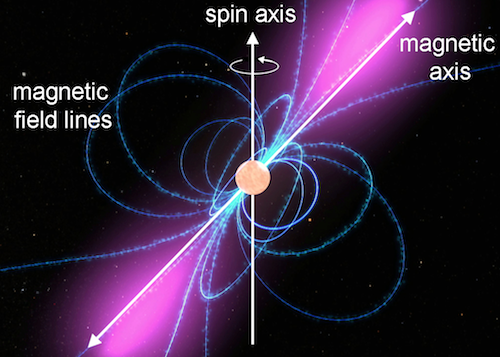
Image credit: NASA; Licence: Public Domain
A pulsar, showing its rotation axis and its magnetic axis.
A neutron star can rotate several times to 1500 times per second. You may have heard the name “Pulser” several times. It is just a rotating neutron star with a strong magnetic field and a perpendicular beam of electromagnetic radiation. We call it Pulsar because it pulse back radio emission constantly with an astronomical accuracy of time gap. Because of this accuracy we use them as like GPS in space. The fastest spinning Neutron star ever detected is PSR J1748-2446ad. Which is situated 18000 light years away from us. PSR J1748-2446ad is spinning at 700 rps and has a speed of 70,000 (24% of C) km per second on its equator.
For more about this, visit- Here
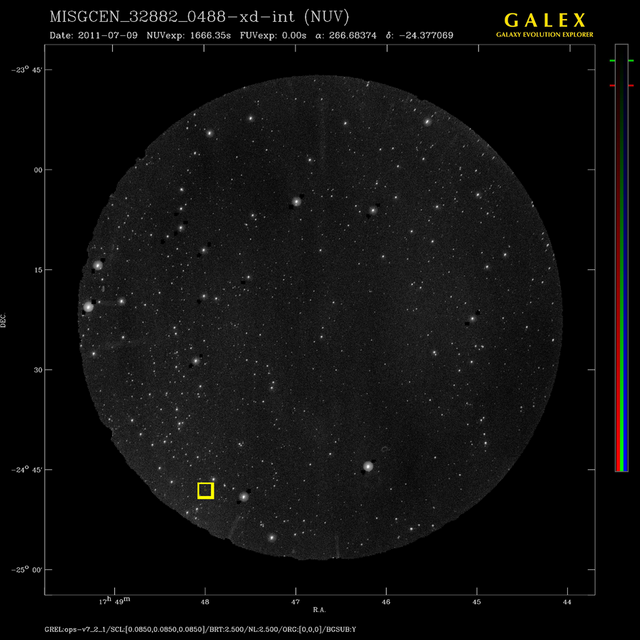
Author: Zellfaze; Licence: CC0
The pulsar is located in the center of the inner yellow square.
If Pulser isn’t enough to amaze you, then here comes Magnetar. This is the last most weird things in the universe which is still a “thing” of our universe. Magnetar is a type of Neutron star with an astronomical magnetic field. For instance, our planet Earth has magnetic field of around 1 gauss and for our star Sun it is few hundred gauss. Where Neutron star like Pulsar has a magnetic field of trillion-gauss, a Magneter has thousand times stronger magnetic field than normal neutron star. Which is up to 1 quadrillion gauss. This is the universal strongest magnetic field generator.
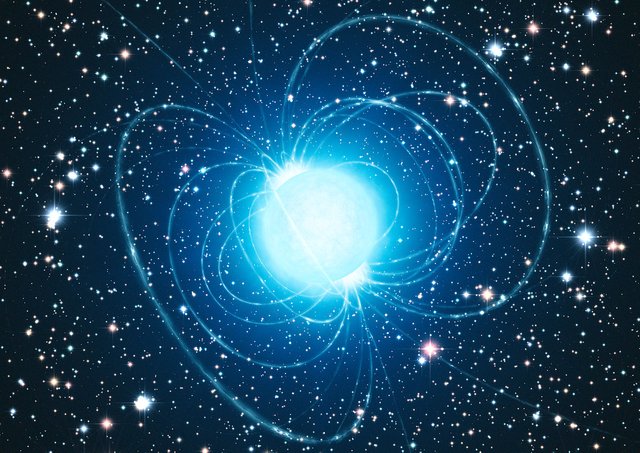
Author: ESO; Licence: CC BY 4.0
Artist’s impression of the magnetar in the extraordinary star cluster Westerlund 1
Bonus fact:
How can something made up of neutral Neutron can produce electromagnetic force in the first place?; Isn’t it weird?
Although the center of any neutron star is made up of neutronium fluid, this isn’t the whole story. Any Neutron star is made up of layer upon a layer. Look the image below to have an idea of it.
Author: Brews ohare; Licence: CC BY-SA 3.0
Even Neutron themselves aren’t fundamental. They are combination of tiny charged Quarks. These intrinsic magnetic moments combined with messy quantum exotic particle, turns the whole star into a conductive ball. As the momentum of primary star is always conserved, the whole angular momentum of that progenitor star is now concentrated on this tiny ball. This is the reason behind it’s massive rotation speed of 10% to 70% of the speed of light. Now, all of these fact is enough for a Magneter having magnetic field of 1 quadrillion gauss. Which is technically 1,000 trillion times stronger than our planet Earth, where you're sitting in right now.
Right now you are thinking that Neutron stars are really scary. A big “YES” to this.
Singularity
Now that we have reached so far, before discussing about Black Hole, we really need to have some raw idea about “Singularity”. The word “Singularity” appears in many places, from abstract math to our real life. For every different aspect it has a different meaning. Generally, whenever we see a problematic point where some its property goes infinite, we consider the result as a singularity. Make sense, huh?
Say mathematics. We all know that 1/0 means infinity. Simply because when you divide 1 by a fraction close to zero you would get a big number. The smaller it gets the bigger the result appears. When its “0” the result doesn’t make any sense, hence it goes to infinity. So, what we have learned from that is- our vocabulary for singularity suggest a special weird conditions of a system or framework, where it can’t justify its result from previous understandings.
It’s true that Math is abstract, we can simply ignore singularity in math by addressing it as undefined. But when it comes to Physics, which means it exists in reality. We can’t just ignore it as an abstract. Can we?!
Newton never really had thought about Black hole. But what if I say you that his theory did it somehow.
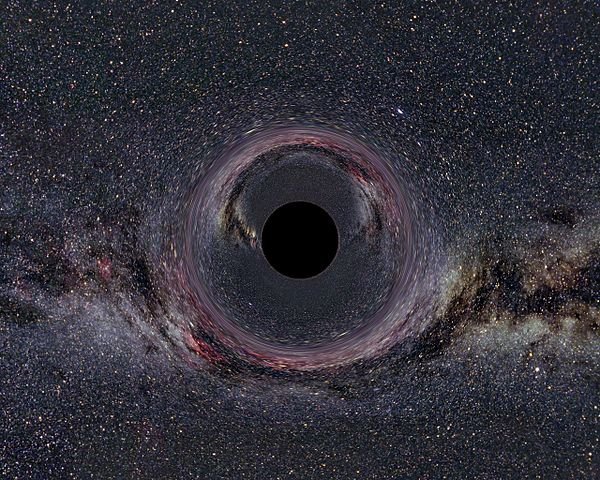
Author: Ute Kraus; Licence: CC BY-SA 2.5
Singularity is hiding itself inside a Black hole.
In Newton’s Law of Gravitation, it says- between any two masses the attraction force is inversely proportional to the square of the distance of separation. Means [F ~ 1 / r], where “F” is the force and “r” is the distance. Look closely to the relation again. What happens when “r” turns to zero. Here we have an another infinity, an infinite amount of attraction force. Which is obvious.
But look from a new angle. Here his theory suggests that, when you get zero distance from the second masses center, the attraction force became infinite. Here it is implying that all of object's mass is located in a 0 sized single point center. Which turns the density to infinity. Now we can say it is safe to call it a Black Hole hence the singularity. Wait, that was just an analogy. We need Einstein’s theory of relativity to successfully predict the behaviour and interactions of an astronomical objects. Because Newton’s law of gravitation or motion doesn’t follow up to that point.
As previously discussed, in 1915 Karl Schwarzschild introduced Schwarzschild metric by using Albert Einstein’s field equations. Take a deep breath, you’re about to experience it.
Schwarzschild metric gives us a coordinate system which defines space-time as the gradient of gravitational force for any given objects. And there is a radius for every object’s mass, where if that mass could be compressed under that specific radius, that object would produce such strong gravitational pulls that nothing can stop that object from collapsing into gravitational singularity or black hole. So, every objects has its own Schwarzschild radius. For the Sun its 3 Km, for Earth it's about 9 Mm, for us it's approximately 1/10 billionth of the radius of a proton and for our observable universe it is approximately 13.7 billion light years. Escape velocity from that singularity becomes more than the casual velocity limits of physics.So that singularity inside Schwarzschild radius prevents everything to escape from it. It’s literally everything, even massless virtual particles like photon.
So the singularity that we have inside a Black Hole is a gravitational singularity. Where we have an infinite spacetime curvature and infinite density from that zero sized singular region.
Say goodbye to our Physics
This one is going to be the most exciting. So, buckle up.
Previously we discussed about Neutron star and their types. We stopped at Magneter, a fast rotating charged neutron star, the last of its kind. If a neutron star gain more masses from a binary star system then there is a huge probability of it being a Black Hole.
There are two types of mass that we are talking about. One is the mass of original star as whole and another is the mass of core remnant. A star can lose or gain mass from a binary star system. After supernova explosion the core of the star remain intact where the outer layer goes away with huge mass. If the core remnant is bigger than 3 solar masses then the star is going to be a Black Hole. Now we explore why.
Energy producing inside of a star keep itself safe from any further gravitational collapse. It's a fair deal between stars own gravity and outward pressure originated from center.
Matter is made up of Proton, Neutron and Electron. Where Proton and Neutron stays at the center as they are far more heavier than Electron. This framework of matter is harmonized by these subatomic particle’s stable interaction. But at the end of exothermic fusion, when density of core rises, Electron loses its predetermined energy state and forced to stay in high energy orbit after filling low energy state. Even if there is not enough energy for electron to do so. Further compression of core is resisted temporarily, because of Pauli exclusion principle. This process is called Electron degeneracy. In this step of degeneracy, density of matter could reach 10,000 kilograms per cubic centimeter. Electron degeneracy is present in the heart of a dying star and inside White dwarf. When it fails to keep the stability due to more stronger inward gravitational push ( For Electron degeneracy it happens when the mass of that object crosses the Chandrasekhar limit, which is approximately 1.3 to 1.5 solar masses), electron got smashed with the Proton and produces Neutron through the beta decay process. And the core converts into an extremely compact nuclear matter, which is mainly Neutronium.
To have a Black Hole now we need to consider 3 rules of Quantum Mechanics. First is Pauli exclusion principle, where it says that two fermion ( ½ integer particles ) can never occupy the same space. Which prevents Electron, Proton and Neutron inside an atom from getting mixed up with their position. Second is Heisenberg uncertainty principle, according to which- one can’t be able to know about position and velocity of a particle simultaneously. Pairs of quantities like position and momentum or time and energy contains a certain level of uncertainty. The last one is the idea of Quantum phase space. We all are well familiar with our 4 dimensional space-time, but Quantum phase space has additional 4 dimensions of Momentum space. Together they make an eight-dimensional world line. Normal space-time is consists of 3-dimensions of space bundled with one time dimension. As like that in Momentum space, 3-dimensions of momentum bundled with energy.
Just like Chandrasekhar limit for Electron-degenerate object, Neutron-degenerate object has Tolman–Oppenheimer–Volkoff limit. Where it suggests that degenerate pressure won’t be able to keep a Neutron star stable above approximately 0.75 solar masses. This is because after filling all of the possible quantum position space by Neutrons, exclusion principle prevents further squeezing. Which now suggests that as the position of each and every Neutron is fixed their momentum is highly uncertain. This uncertainty of momenta expands the Momentum space for Neutrons. The denser the star is (Or gets over time) the more the momentum space expands and the more it gets smaller. This process goes on politely until the radius of that Neutron star overlaps with it's own Schwarzschild radius. To make a handshake with the inevitable Singularity, all position space of matter collapses to inward singular points and momentum space expands accordingly. Our current understandings of physics can’t tell us what ultimately happens to the building block Quarks or Quark-Gluon pair as they squeezed to the Planck point.
Yep, you got it. Now it's a Black Hole. Nothing can escape from it's horizon. For example-
Escape velocity of planet Earth is :11.2 km / second.
Escape velocity of Moon is : 2 km / second.
Escape velocity of Sun is : 620 km / second.
Escape velocity of a Neutron star is : Approx 0.3 to 0.5 c ( c = speed of light).
Escape velocity of a Black Hole is : Bigger than the speed of light.
Event horizon
As the Neutron star slips through its own Schwarzschild radius, causal relation with this universe is no longer exists. It is separated by the Event Horizon.
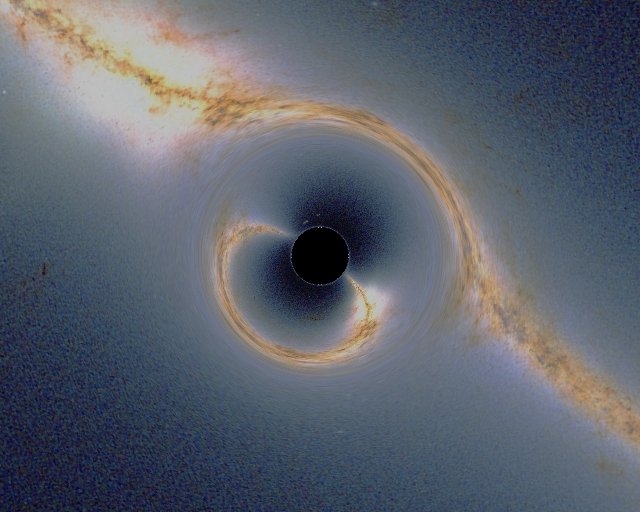
Author: Alain r; Licence: CC BY-SA 3.0
A simulation of Schwarzschild black hole.
Anything with mass distorts space-time. According to Einstein’s GTR (General Theory of Relativity), gravity isn’t a force. Wait, wait, wait, it’s true. We consider the attraction force between two object is solely because of their gravity. The view is right but not the mechanics. Gravity warps space-time and matter interacts via those curved space-time. As by John Archibald Wheeler- “Spacetime tells matter how to move; matter tells spacetime how to curve.”
The more mass an object has the more curvature it can create. Any other object just accelerate towards it through this extreme bends on space-time. Like Earth rotating around Sun or Moon rotating around Earth. That path that an object follow to accelerate through the space-time is called “Geodesic”.
Event horizon is a region around black hole from where all geodesics are pointed inward to that singularity. That boundary is spherical. For thought experiment, this is from where escape velocity exceeds the speed of light. Boundary created by event horizon separates any events that happens inside a black hole from outside universe. For an observer outside a black hole there is no meaningful “now” inside event horizon. In our timeline nothing ever happens inside a event horizon. It is a frozen area of happenings. Any happenings below the event horizon stays below the event horizon, isolated forever. Current understandings of reality breaks down after event horizon. Space and Time changes their roll after event horizon. Time become spacelike and space turns out to be time like.
Types of Black holes
Regarding the mass and size of a Black Hole, we can divide them into 4 types. Which are following-
1: Micro Black Hole : Micro or miniature black holes might have produced at the moment the universe was created. During the Big Bang. They are theoretical, never observed. If they are real, heaviest of them would weight less than the moon. With a possible diameter from slightly above planck limit to about 0.25 millimeter. They evaporate at a rapid speed due to Hawking radiation, which depends on their mass. The smaller the faster.
2: Stellar Mass Black Hole (SMBH): Stellar Mass Black Holes are formed when massive star collapses. If a Neutron star gets more mass - from a binary star system - above it's limit it would eventually collapse into a stellar mass Black Hole. They are normally sized between 5 to near 100 solar masses.
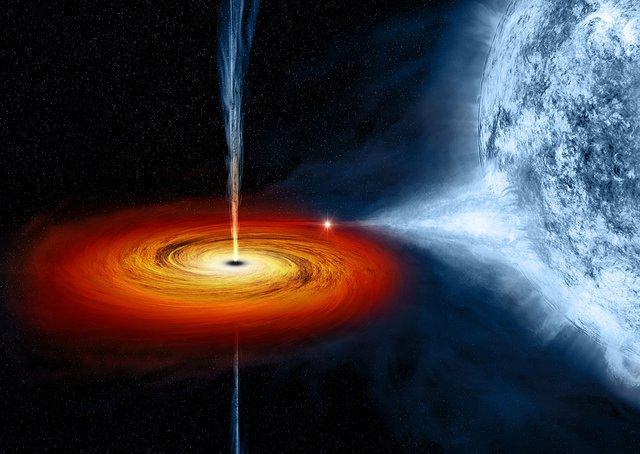
Author: NASA; Licence: Public Domain
Artist's impression of a Stellar Mass Black Hole sucking mass from its companion star
3: Intermediate-mass Black Hole (IMBH): This class of Black Hole has a mass range of about 100 to 100000 solar masses. They are slightly bigger then SMBH and smaller than Supermassive Black Holes. GCIRS-13E is the first observed intermediate-mass black hole in our galaxy. Another IMBH is HLX-1, which is estimated to be 7x 10^4 solar masses.
.jpg)
Author: NASA; Licence: Public Domain
That white circled area has a possible intermediate-mass black hole.
4: Supermassive Black Hole : Supermassive black hole is present at the center of every galaxy. They are the main ingredients of a Quasar. They are as massive as millions or billions of Suns. In the case of our Milky Way galaxy, there is a Supermassive black hole 26,000 light-years from the Solar System, at the location of Sagittarius A. Which is weighted around 4.3 million solar masses.
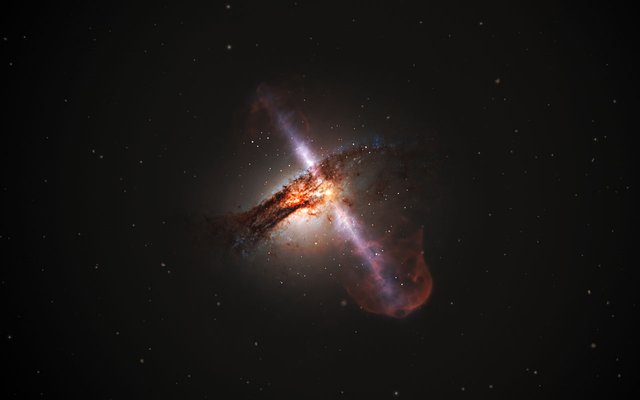
Author: ESA/Hubble, L. Calçada (ESO); Licence: CC BY 4.0
Artist’s illustrates how high-speed jets from supermassive black holes would look
No-hair theorem
Black Holes are the most mysterious objects on cosmos yet they are the most simplest one. That's because one can express a black hole fully just by its three properties. They are Black holes mass, electric charge and it's spin or angular momentum.
Those three information is all that exists now. All other information about the originate star or falling matter disappears behind the boundaries of event horizon. To the outside universe this information is lost forever. And this no-hair theorem of black holes is central to the information
Paradox coined by Stephen Hawking. Where he proposed that all information of a Black hole is woven in 2-dimensional surface of it's event horizon.
Hawking Radiation
Black hole does one thing in an artistic way. That is merging the tiny quantum world and gravity at bigger scale. We have seen how quantum theories like Pauli exclusion principle and Heisenberg uncertainty principle works together to shape a black hole. In 1974 physicist Stephen Hawking predicted another quantum effect which suggests a constant radiation will emit from the event horizon.
Empty space is full of quantum vacuum fluctuations. Where it ends up with result like pair of particle and antiparticle. Just outside the event horizon due to enormous gravitational energy, this process get boosted up. Imagine a pair of particle-antiparticle produced close to the event horizon. Here the theory suggests that the negative particle on the pair will fall into the Black hole and the positive particle will escape as a form of radiation. Thus this negative particle with negative mass, energy will help Black hole to lose its mass. This process goes on until the black hole evaporates totally by radiating all of its mass equivalent energy in form of Hawking radiation. As a black hole evaporates, information of that black hole also evaporates. But this can't be. Information is conserved in this universe. This rises a new paradox “Information Paradox”. TLDR, physicist Leonard Susskind proposed that information of a black hole is preserved in two-dimensional plane of three-dimensional event horizon. Even this could be true for the whole universe. The “Holographic theory”, where the reality is from a two-dimensional holographic plane.
Hunt for Black Holes
Our Milky Way galaxy alone consists of 10 million to a billions of stellar mass black hole. They are only observable through their gravitational influences. There is another way to detect them. Gas and dust falling into a black hole releases a huge amount of energy in forms of infrared, visible and X-ray. Normally X-ray radiation remain untouched and unchanged throughout their intergalactic journey as they don’t get absorbed by dust. In 2012 NASA had sent NuSTAR (Nuclear Spectroscopic Telescope Array), which was the first satellite to explore the universe in the eyes of high-energy X-rays. Now there is an international collaboration going on to make a virtual Earth-sized telescope. This is The Event Horizon Telescope. It uses radio telescopes around every corner of Earth and by combining their data, it is trying try to provide us the first photograph of a black hole. Insane, huh?
Inspirations and sources:
About Element Abundance. Here; Here
About Stellar Remnants. Here; Here; Here.
About stars life cycle. Here; Here; Here; Here.
About quantum phase space. Here; Here; Here.
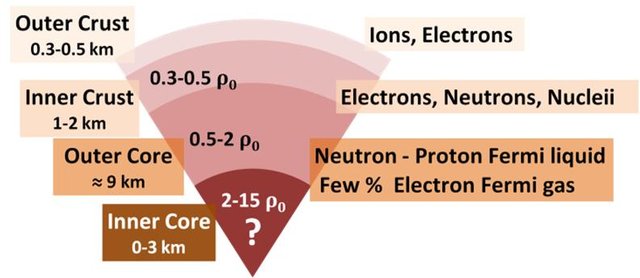
Have questions?
Never mind asking.
Congratulations @dolon! You have completed the following achievement on Steemit and have been rewarded with new badge(s) :
Click on the badge to view your Board of Honor.
If you no longer want to receive notifications, reply to this comment with the word
STOPTo support your work, I also upvoted your post!
Do not miss the last post from @steemitboard:
SteemitBoard World Cup Contest - The results, the winners and the prizes